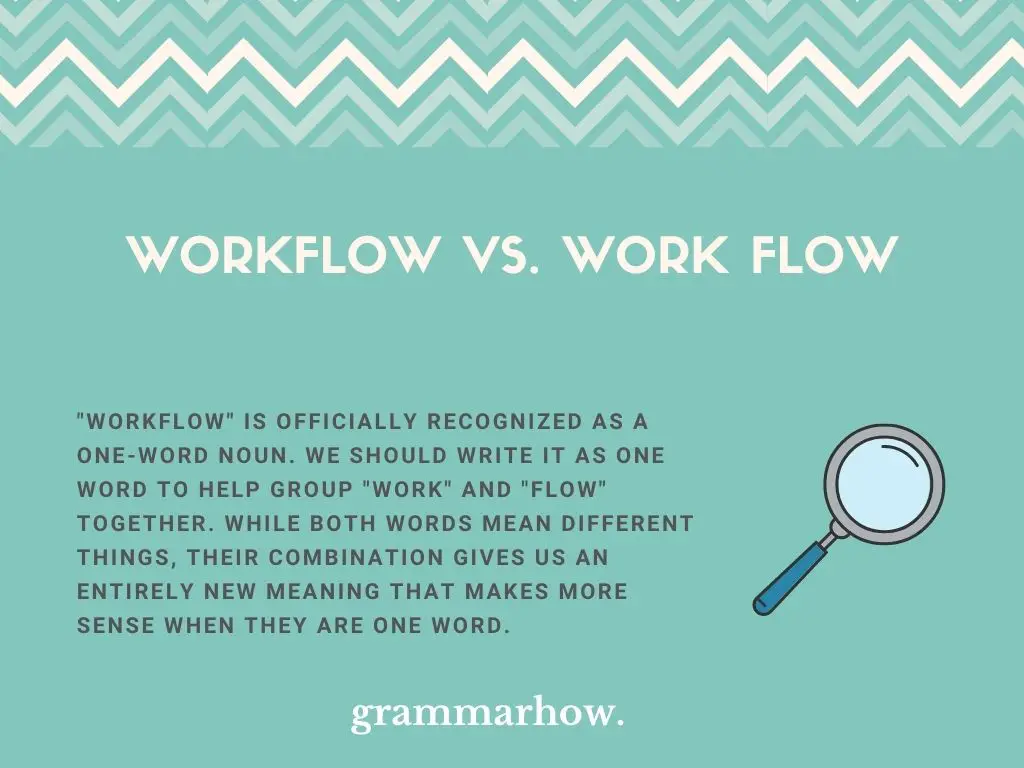“Workflow” is important in any business. It helps to demonstrate how work is organized within a company. It would help to know how to write it. Is it one or two words? This article will answer that question and everything else for you!
Workflow vs. Work flow
“Workflow” is officially recognized as a one-word noun. We should write it as one word to help group “work” and “flow” together. While both words mean different things, their combination gives us an entirely new meaning that makes more sense when they are one word.

According to Google Ngram Viewer, “workflow” is the vastly more popular choice. You might notice that “work flow” is barely used in comparison, and that’s because it’s just not the choice you want to work with if you can avoid it.

In The Cambridge Dictionary and The Oxford Dictionary, “workflow” is one word. Both dictionaries define the word as a singular entity, and both of them give the same definition and highlight that it is a noun.
Neither dictionary says anything about “work flow.” While the two words are defined separately in other instances, when we want to use them together, it only makes sense if we remove the space between them.
“Workflow” is more helpful to us because it shows that we are working with the way work is organized. Without the space, it gives many native readers a chance to realize that the two words interact with the sentence together rather than separately.
Is “Workflow” One Word?
You should always write “workflow” whenever you are using it. It is a singular-word noun that makes sense in every case it’s written in. Including the space is a waste and does not aid the reader in their understanding of what they are supposed to interpret.
Some words that are made up of more than one separate word keep the space. This is only done when it seems logical that the two words interact with each other in a specific way.
Since “workflow” interacts with the rest of the sentence in some way, the two words are always combined. The space is a redundancy that can be ignored in all written cases.
Why not give some of these examples a look to see what you make of it:
- We need to revisit his workflow strategies because I do not agree with any of them.
- The workflow within this office seems to be a bit all over the place! I think it’s time we fixed that.
- You haven’t figured out the workflow yet, have you? That’s usually the first thing you should do.
- I don’t agree with the workflow targets. Maybe it’s better if we tried them from a different angle.
Is “Work flow” Two Words?
“Work flow” is not two words. We do not write them as separate words because we need to show that “work” and “flow” have a different meaning when they are written together. The space is irrelevant in all written cases, so you should avoid using it when you do.
It might help if you checked out the following examples to see what you make of the incorrect variation:
- Correct: I need you to look into the workflow right away. I’m concerned that some people are not living up to their potential.
- Incorrect: Do we have to talk about the work flow again? I feel like there are more pressing matters to discuss.
- Correct: I don’t agree with your workflow tactics. They seem overwhelming to most of us, but I’ll let them slide.
- Incorrect: The work flow within this office isn’t something you can correct. It’s best if you leave it as is.
There is never a case where “work flow” is the correct choice. You should always avoid it when you are writing about work processes or organization.
Tip To Remember The Difference
Since “workflow” is the only correct variation, it would be helpful to know a tip to remember it.
“Workflow” is all about speed and efficiency. It’s about how work passes through the system and how processes are carried out. Since the best “workflow” tends to be streamlined and quick, we should always write it as one word because it’s the most streamlined and quick spelling.

Martin holds a Master’s degree in Finance and International Business. He has six years of experience in professional communication with clients, executives, and colleagues. Furthermore, he has teaching experience from Aarhus University. Martin has been featured as an expert in communication and teaching on Forbes and Shopify. Read more about Martin here.
